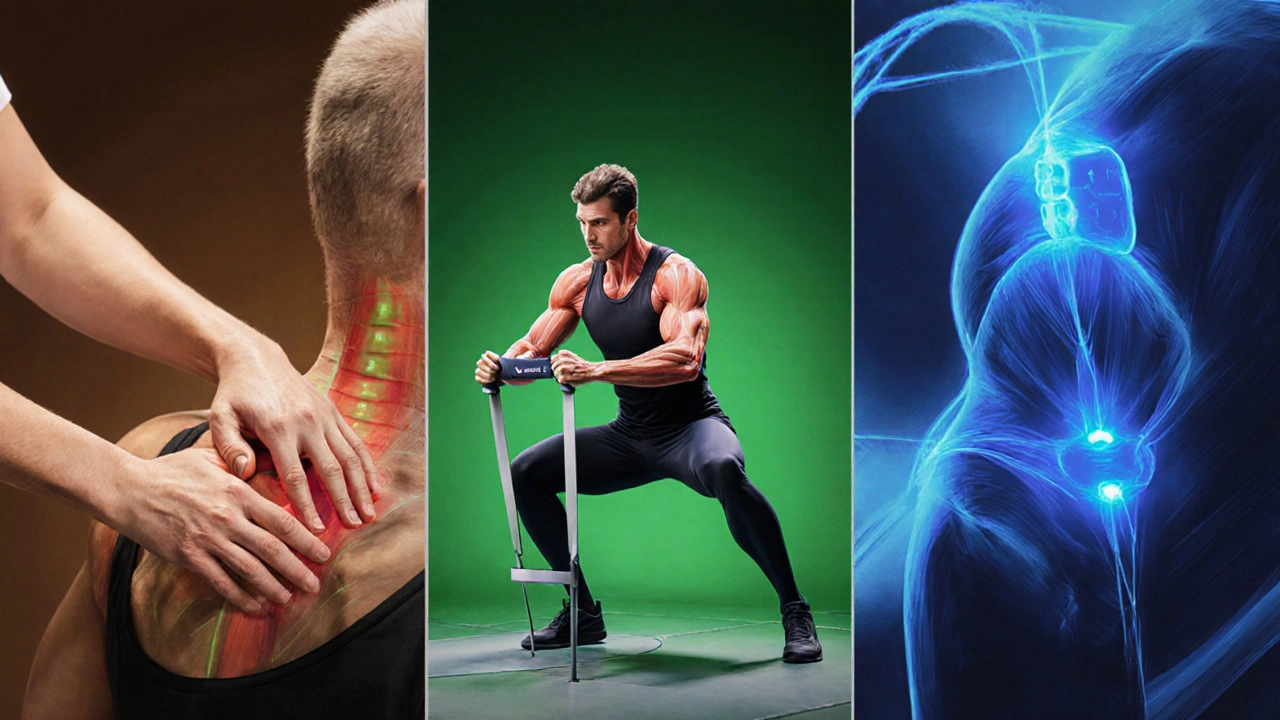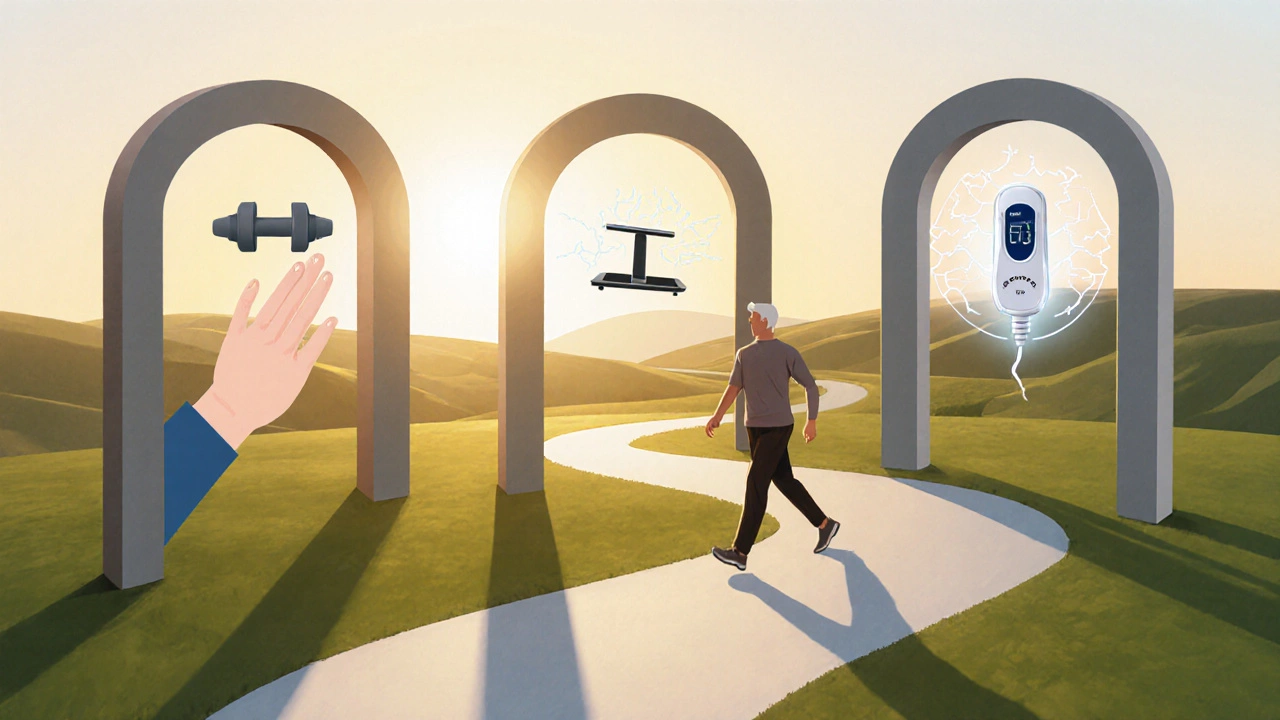 Oct, 23 2025
Oct, 23 2025
Physiotherapy Type Selector
Find the Right Physiotherapy Approach for You
Answer a few questions to discover which physiotherapy type best addresses your needs. This tool uses the latest clinical guidelines to recommend appropriate treatment options.
What are your primary symptoms?
How long have you been experiencing symptoms?
What are your primary treatment goals?
Recommended Physiotherapy Approach
Your personalized recommendation will appear here based on your responses.
Quick Takeaways
- Physiotherapy splits into three main branches: manual therapy, exercise therapy, and electrotherapy.
- Each type targets specific conditions - from joint pain to neurological disorders.
- Choosing the right approach depends on your injury, goals, and therapist expertise.
- Local clinics often combine all three for a customized plan.
- Understanding the differences helps you ask the right questions at your first appointment.
What is Physiotherapy?
When you hear the word Physiotherapy is a health‑care profession that uses movement, manual techniques, and specialised equipment to restore function and reduce pain. It’s not just “exercise”; it blends science and hands‑on skill to address musculoskeletal, neurological, and cardiopulmonary issues. A licensed Physical therapist is a trained professional who evaluates, diagnoses, and treats movement‑related problems. In everyday language you’ll hear people say they’re “seeing a physio” - that’s short for a physiotherapist helping them move better.
The Three Core Types of Physiotherapy
While the field is vast, most treatment plans draw from three primary modalities. Knowing the difference lets you match therapy to your specific need.
1. Manual Therapy
Manual therapy refers to hands‑on techniques such as joint mobilisations, soft‑tissue massage, and myofascial release. The therapist uses their hands, elbows, or tools to manipulate muscles, joints, and connective tissue. Benefits include increased range of motion, reduced muscle tension, and quicker pain relief for acute injuries like sprained ankles or tension‑type headaches. Research from the 2022 Journal of Orthopaedic & Sports Physical Therapy shows that patients receiving manual therapy alongside exercise recover up to 30 % faster than exercise alone.
2. Exercise Therapy
Exercise therapy involves prescribed movements, strength training, balance drills, and aerobic conditioning tailored to the individual. It’s the backbone of long‑term rehabilitation for conditions like chronic low‑back pain, osteoarthritis, and post‑surgical recovery. By progressively loading muscles and joints, you rebuild strength, improve proprioception, and prevent future injury. A 2023 systematic review reported that exercise therapy reduces pain scores by an average of 2.3 points on the 10‑point scale for knee osteoarthritis patients.
3. Electrotherapy
Electrotherapy covers the use of electrical currents - such as TENS, ultrasound, and IFC - to modulate pain signals and promote tissue healing. It’s especially useful for neuropathic pain, post‑stroke spasticity, and deep‑tissue injuries where manual techniques can’t reach. For example, transcutaneous electrical nerve stimulation (TENS) delivers low‑frequency currents that distract pain pathways, while therapeutic ultrasound generates heat deep in muscle fibers, accelerating collagen remodeling. Studies from the American Physical Therapy Association note a 20 % improvement in pain relief when electrotherapy is added to a standard exercise program.

Side‑by‑Side Comparison of the Three Types
| Attribute | Manual Therapy | Exercise Therapy | Electrotherapy |
|---|---|---|---|
| Primary Goal | Restore joint mobility & reduce muscle tension | Build strength, endurance, and functional movement | Modulate pain signals & stimulate tissue repair |
| Common Techniques | Joint mobilisations, myofascial release, trigger‑point therapy | Resistance training, balance drills, aerobic conditioning | TENS, ultrasound, interferential current (IFC) |
| Typical Conditions Treated | Acute sprains, neck pain, post‑manipulation stiffness | Chronic low‑back pain, post‑operative rehab, osteoporosis | Neuropathic pain, spasticity, deep‑tissue inflammation |
| Session Length | 15‑30 minutes per area | 30‑60 minutes (often home program follows) | 10‑20 minutes per modality |
| Evidence of Effectiveness | Meta‑analyses show ~25 % faster range‑of‑motion gains | Strong support - reduces pain & disability in >70 % of studies | Moderate support - best as adjunct to other therapies |
How to Choose the Right Type for Your Situation
There’s no one‑size‑fits‑all answer, but a few practical rules help you decide:
- Acute pain or stiffness? Start with manual therapy to unlock tight joints. It can be a quick “reset” before moving on to exercises.
- Long‑term functional goals? Exercise therapy is the workhorse. It builds the strength and coordination you’ll need to stay healthy.
- Neuropathic or deep‑tissue pain? Electrotherapy can target nerves and tissues that are hard to access manually.
- Budget or time constraints? Many clinics bundle services, so ask for a combined plan that maximises benefit per visit.
Remember, most physiotherapists blend all three. A typical 6‑week program might begin with two manual‑therapy sessions per week, transition to three exercise‑focused visits, and add a weekly electrotherapy session for persistent pain.
Finding a Qualified Physiotherapist Near You
If you typed “physiotherapy near me” into Google, you likely have a clinic in mind. Here’s how to turn that search into a confident choice:
- Check credentials. Look for a registration number with the Health and Care Professions Council (HCPC) in the UK or the state board in the US.
- Specialisation matters. Some therapists focus on sports injuries, others on neurological rehab. Match their expertise to your condition.
- Read reviews. Real patients will mention whether the clinic uses a mix of the three therapy types you’re interested in.
- Ask about assessment. A good first visit includes a thorough movement analysis, not just a quick tap‑and‑go.
- Location & parking. Convenience matters for adherence - a short commute increases the likelihood you’ll stick to the program.
When you call, try these questions: “Do you incorporate manual therapy, exercise, and electrotherapy in your treatment plans?” and “How often will I need to come for each modality?” Clear answers will save you time and money.

Common Misconceptions About Physiotherapy Types
Myths can steer people away from effective care. Let’s bust a few:
- “Manual therapy alone cures everything.” It’s great for short‑term relief, but without exercise you risk re‑injury.
- “Exercise therapy is just boring gym work.” Modern exercise prescriptions are highly targeted, often using body‑weight drills, resistance bands, or functional tasks you’ll actually use daily.
- “Electrotherapy is dangerous.” When applied by a qualified therapist, current levels are low and specifically calibrated for safety.
- “Physiotherapy is only for athletes.” In fact, the elderly, post‑operative patients, and anyone with chronic pain benefit from these modalities.
Putting It All Together: A Sample 8‑Week Plan
Below is a practical template you can discuss with your therapist. Adjust based on diagnosis and therapist advice.
| Week | Focus | Sessions |
|---|---|---|
| 1‑2 | Pain reduction & joint mobility | Manual therapy (2×/wk) + Gentle exercise (1×/wk) |
| 3‑4 | Strength building & functional movement | Exercise therapy (3×/wk) + Manual therapy (1×/wk) |
| 5‑6 | Deep tissue healing & neuromuscular control | Electrotherapy (1×/wk) + Exercise therapy (3×/wk) |
| 7‑8 | Return to activity & maintenance | Exercise therapy (2×/wk) + Review of manual/electro options as needed |
Track pain levels, range of motion, and daily activity scores each week. Sharing this data with your therapist helps them tweak the mix of manual, exercise, and electro modalities for optimum results.
Frequently Asked Questions
What is the difference between a physiotherapist and a chiropractor?
Physiotherapists use a blend of manual therapy, exercise prescription, and electrotherapy to restore movement. Chiropractors focus mainly on spinal adjustments and joint manipulation, often without a structured exercise component.
Do I need a doctor’s referral to see a physiotherapist?
In many countries (including the UK) you can book a physiotherapy appointment directly. In the US, some insurers require a referral for coverage, but you can still see a therapist privately.
How many sessions will I need?
The number varies by condition. Acute injuries may improve in 4‑6 sessions, while chronic issues often need 8‑12 weeks of combined therapy.
Is electrotherapy painful?
When set correctly, the sensation is mild - like a tingling or warm sensation. Your therapist will adjust the intensity to keep you comfortable.
Can I do any of these therapies at home?
Exercise therapy is the easiest to continue at home with provided worksheets or apps. Some handheld TENS units are available for self‑use, but manual therapy always requires a trained professional.
Understanding the three main types of physiotherapy gives you the confidence to ask the right questions, stick to a plan, and get back to the activities you love. Whether you’re searching for “physiotherapy near me” or just curious about how these modalities work, the key is a tailored mix that addresses your unique goals.
